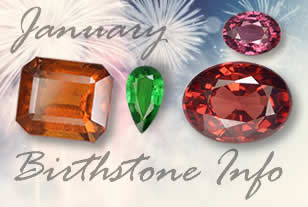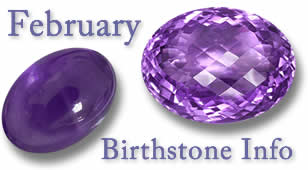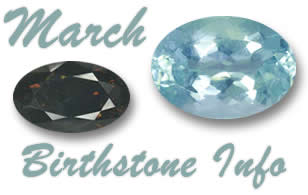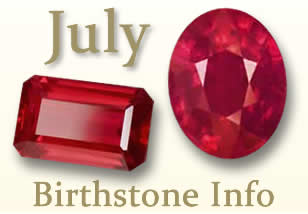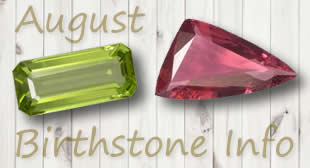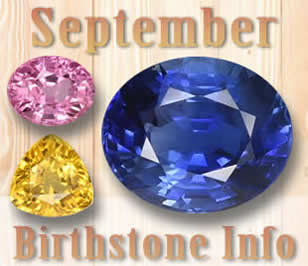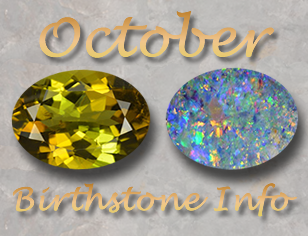What can I find in this article?
- What is the color of the December Birthstones?
- The Etymology, History and Lore of the December Birthstones
- What is the spiritual meaning of the December birthstones?
- The healing properties of the December birthstones
- What is the durability of the December birthstones?
- Cleaning and caring for turquoise, tanzanite and zircon
- How much do December birthstones cost?
- Are there any secondary December birthstones?
- Final Thoughts
The December Birthstone: Turquoise, Tanzanite and Zircon
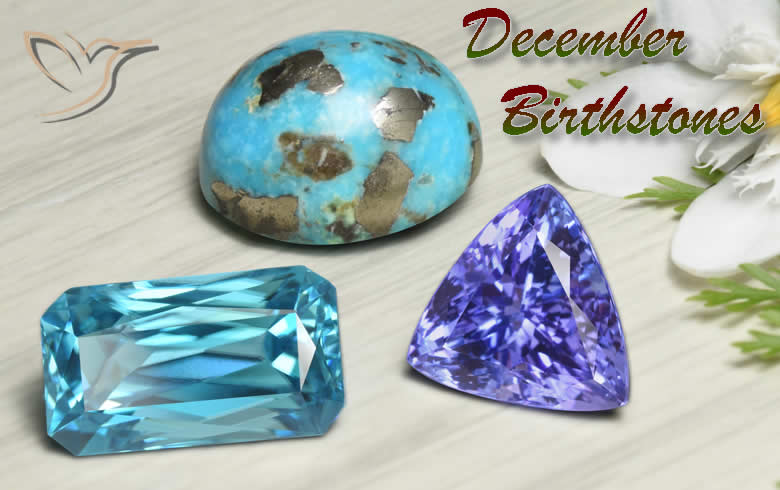
From medieval times, until the 1921 Jewelers of America (JA) official birthstone listing, bloodstone and ruby were considered December birthstones. The JA list not only selected two gemstones to represent this month, it started a color theme that would persist, through different December birthstone options, to today. That theme is blue. While turquoise, lapis lazuli, zircon, tanzanite and even topaz are recognized for their connection to December, it is the color blue that remains the common denominator among these December birthstones. For the purposes of this article, we will focus on the three most popular contemporary December birthstones - turquoise, tanzanite and zircon.
The color of turquoise
As previously mentioned, blue is the color that saturates the birthstone options for December. Used for millennia to convey and project loyalty, wisdom, strength and trust, blue is a calming color that evokes images of the sky and the sea. A primary color that lies between green and violet, blue is a very popular color because it tends to look good in any shade, making it ideal for fashion - jewelry in particular.
The name turquoise is synonymous with blue; although the gemstone turquoise has a few color variations, we use the word turquoise as an adjective referring to a specific frequency of light: turquoise blue. Other varieties in the turquoise color range are celeste (a sky-blue), light turquoise, medium turquoise (a shade darker than turquoise blue), dark turquoise (the darkest shade), and bright turquoise (somewhere between turquoise blue and medium turquoise). Furthermore, this color range extends from the blue tones into green.

The color of tanzanite
In its rough state, tanzanite can be a reddish brown to clear; the popular blue hues are achieved through heat treatment. While generally considered a blue gemstone, tanzanite can be found in colors that range from royal blue to indigo and violetish purple.
Tanzanite displays a sort of magic: it can show sapphire blue, violet or burgundy when viewed from different angles. This phenomenon is called trichroism. Pleochroism (showing different colors from different angles) is common in gemstones; sapphire, for example, is dichroic - it shows two different colors. Trichroism (three colors) is extremely rare and tanzanite is one of the only gemstones known to exhibit this effect.

The color of zircon
Zircon has the most diverse color range of these three December birthstones, of which white, or colorless, is likely the least valuable or important. The most popular zircon today is blue zircon, usually occurring with green pleochroism, which can result in interesting teal-like colors.
Blue zircon is actually produced by heating the more commonly occurring brown zircon. However, only some brown specimens of zircon have the appropriate physical structure to turn blue when heated. Typically these types of deposits are found in South East Asia, which is why most blue zircon comes from Cambodia or Myanmar (Burma).

Turquoise
This unique mineral has been used for thousands of years as an ornament and known by many names during this span of time. Referred to by the ancient Greeks as callais (green gemstone) and by the Aztecs as chalchihuitl (precious green gemstone, or "heart of the earth"), turquoise was given its modern name by the French, who called it pierre turquois (Turkish stone) - as this gemstone was first brought back to Europe from Turkish mines.
The use of turquoise as a decoration and talisman can be found throughout the ancient world, as far back as six thousand years ago when Egyptians used it to adorn their bodies and tombs; the most well-known of these is the tomb of Tutankhamun. This pharaoh's resting place was discovered in-tact and revealed a burial mask liberally inlaid with turquoise.
Turquoise became popular during the Shang Dynasty (2nd millennium B.C.) in China, when it was carved into figurines and ornaments. More recently, the Aztecs (1300 - 1521) used turquoise to decorate their ceremonial masks, knives, and shields. This cultural occurrence then travelled north, to the Pueblo, Navajo and Apache tribes of the American Indians, who valued turquoise as an amulet that could impart precise aim to an archer, among other benefits.
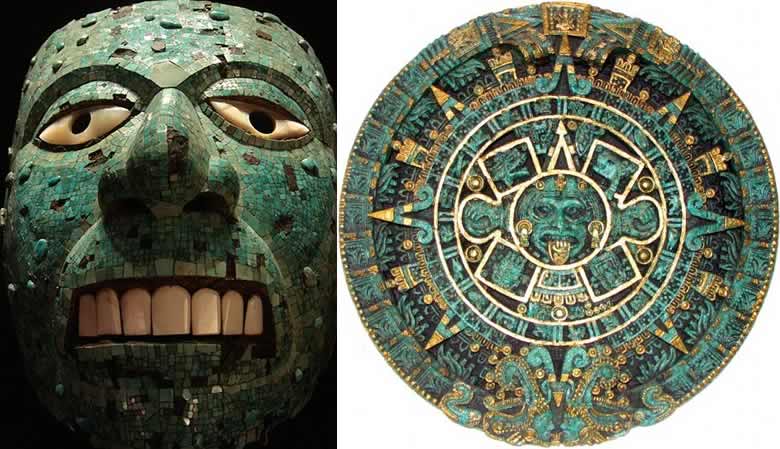
Our contemporary use of turquoise in the West may be, in part, thanks to a 14th century decree from the Roman Catholic Church, allowing turquoise to be used in secular jewelry.
As with many gemstones, turquoise has for centuries been thought of as an amulet to protect the wearer from evil. This belief is often contingent, however, on receiving the turquoise from a friend; it is thought that the power to ward off evil is activated in the stone by the bond of friendship. Moreover, the qualities of the turquoise are thought to be influenced by the wearer, and that it can take on different colors depending on who wears it. There are also tales of a turquoise gemstone growing pale upon the death of its owner.
Turquoise also has a strong historical connection to horses and their riders. As a common ornament attached to a bridle, turquoise was thought to prevent the rider from falling, as well as protect the horse from thirst and exhaustion, make them sure-footed, and obedient.
The best quality turquoise is located in Northeast Iran. Turquoise deposits are also found in Afghanistan, Argentina, Australia, Brazil, China, Israel, Mexico, Tanzania and the USA.
Tanzanite
The name for this December birthstone has a very recent etymology and is derived from its source - a small area in the Merelani Hills of Tanzania. In fact, tanzanite is found in no other location in the world, making this gemstone incredibly rare and valuable.
Tanzanite is scientifically known as blue-violet zoisite; as this name has virtually no consumer appeal, the marketing department of Tiffany & Co. recognized tanzanite's commercial value and replaced the name in 1968.
First discovered by Manuel de Souza, a Goan tailor, in 1967, tanzanite was mistaken for peridot. After a convoluted path that took the tanzanite samples from the Merelani Hills to Kenya, then Saks Fifth Avenue in New York, and across the street to the Gemological Institute of America, tanzanite was finally and correctly identified as a mineral variety of zoisite.
Due to its relatively brief history, there is very little presence of tanzanite in culture; however, it is used extensively today in metaphysical healing and spiritual exploration.
Zircon
The etymology of zircon is traced back to the Persian word zargun (golden-hued) and was corrupted into the word jargon, a French word used to vaguely refer to high-quality, diamond-like gemstones. Zirkon, the German adaptation of this word, was eventually modified to become the English word zircon.
Zircon is actually the oldest known mineral on Earth; some samples have been dated 4 billion years old. Australia claims deposits that date back this far.
During the Medieval Period (the 5th to 15th century A.D.), zircon, known then as jacinth or hyacinth, was used to aid sleep, bring prosperity, and promote honor and wisdom in its owner.
Popular during the Victorian era (1837 - 1901), zircon is often found in English estate jewelry (jewelry that is antique, vintage or of importance). Around this time, George Kunz, a renowned gem buyer at Tiffany & Co., attempted to boost zircon's reputation by renaming it "starlite", though this name did not catch on. Throughout the 1900s, zircon was used as a diamond imitation, leading its name to become synonymous with "fake".
Today, zircon has shed the negative connotations to become an extremely popular gemstone. Australia leads the zircon market and contributes 37% of the world's supply, followed by South Africa, which produces 30% of the supply. A great deal of zircon deposits come from Cambodia, Myanmar (Burma), and other notable sources include Brazil, Korea, Madagascar, Mozambique, Nigeria, Sri Lanka, Tanzania, Thailand and Vietnam.
The meaning of turquoise
Evocative of the sky and sea, turquoise is a protective gemstone that dispels negativity and symbolizes good luck, inner calm, stability, self-realization, and creativity. As a zodiac stone for the sign Sagittarius, turquoise is associated with the qualities of this sign, particularly optimism, kindness and adventurousness. Turquoise can also be given on the 5th and 11th wedding anniversaries.
The meaning of tanzanite
The cool blues and purples of tanzanite symbolize calm and the ability to soothe. Blue also embodies responsibility and reliability, while conveying security and trust. Perhaps this is why tanzanite is given on the 24th wedding anniversary.
Tanzanite was recently voted the second most popular gemstone in the U.S., an accolade that testifies to the spiritual importance of this December birthstone.
The meaning of zircon
Apart from its shared associations with the color blue and its significance, zircon expresses balance, spiritual grounding and healing. Blue zircon is connected to happiness, prosperity and honor and can be given on the 4th wedding anniversary to convey these meanings.
The healing properties of turquoise
Thought to facilitate friendship, leadership and clear communication, turquoise is believed to prevent and cure a host of physical and spiritual ailments. Known as a strengthening stone, turquoise can cure exhaustion, anxiety and depression. This December birthstone is also known as an anti-inflammatory and detoxifying agent that can reduce excess acidity, benefit gout, rheumatism, and ailments of the stomach.
Turquoise is also believed to alleviate migraines and benefit the overall health of the brain, eyes, ears, neck, lungs and throat. In Ayurveda, the traditional Hindu medical system, turquoise is associated with clearing Ajna, or the third eye chakra, and Vishuddha, the throat chakra. Ajna is connected with the pineal gland, the pituitary gland, intuition and the intellect. Vishuddha is linked to purification, wisdom, verbal communication, the ears, neck and throat.
Turquoise is often considered a crystal for travel and can protect you and your belongings from loss or theft while on your journey.
Attached to the collar of a pet, it guard your animals from going astray or being stolen. Promoting clear communication in the workplace, turquoise is a recommended amulet for those working in law or government. It is also suggested that accountants and IT professionals wear turquoise to release anxiety and induce mental relaxation.
The healing properties of tanzanite
Tanzanite shares many of turquoise's healing powers, imparted to it by the color blue and its healing traits. It has been known to strengthen the immune system, detoxify the blood, and improve vitality. This December birthstone is also thought to promote the regeneration of cells, skin and hair, in addition to protection from the negative side-effects of medical or surgical intervention.
Beneficial in the treatment of psychological stress and disorders, tanzanite is also useful to cure excessive sweating, relieve migraine headaches, and aid the recovery from alcoholism.
Tanzanite has a place in Feng Shui, the Chinese system of arranging the living space to maximize the flow of positive energy. Feng shui prescribes the use of tanzanite to increase the water energy (deep blue tanzanite) and the fire energy (purple-blue) in the home. These energies promote calm and stimulate enthusiasm, respectively.
The healing properties of zircon
Known since the medieval times to aid sleep, bring prosperity, and promote wisdom and honor to those who wear it, zircon has also been considered beneficial in the prevention and treatment of varicose veins, blisters and problems with the testicles.
As zircon occurs in a range of colors, it can be used for a variety of psychic healing treatments and when focusing on the different chakras during meditation. Overall, as a grounding crystal, zircon can bring physical, emotional and spiritual balance, allowing you to love yourself and others.

The durability of turquoise
The concept of durability is comprised of three factors: hardness (resistance to scratching), toughness (resistance to chipping, cracking and breakage), and stability (resistance to chemical or environmental shock). On the Mohs hardness scale (an index from 1- the softest- to 10 - the hardest), turquoise has a rating of 5 - 6. To put this into perspective, quartz, the second most abundant mineral on Earth, is at 7 on the Mohs scale.
This is an important point because the inescapable presence of quartz means that it is airborne, can settle on jewelry, and be thoughtlessly wiped away, causing scratches to any material lower than Mohs 7. As a result, special care must be taken when wearing, cleaning and storing turquoise to avoid scratches from gemstones and materials higher on the hardness scale, such as ruby (Mohs 9) or titanium (Mohs 7).
All gemstones are considered brittle to some degree, because they will eventually break, or cleave, when struck with enough force. For example, jade is the toughest gemstone and can be worn every day for years without a crack appearing, while topaz is considered to have poor toughness.
Toughness in gemstones is rated as exceptional, excellent, good, fair or poor. Turquoise has perfect cleavage (it is easily and cleanly cut), but its toughness is considered fair to good. This means that turquoise jewelry can survive a knock or two on a hard surface, though this should always be avoided with all gemstone jewelry. It is recommended to set turquoise in protective metal mountings and bezels
Turquoise is typically stable in light, although intense heat from light or other sources can cause discoloration and damage to the surface. Moreover, turquoise can be discolored by chemicals, cosmetics, skin oils and perspiration. Hydrochloric acid, a chemical commonly found in household cleaning products, causes turquoise to dissolve.
The durability of tanzanite
Tanzanite is considerably harder than turquoise, ranging from 6 to 7 on the Mohs index, and it too has a toughness rating of good to fair; so, tanzanite can be worn in all types of jewelry with the appropriate care.
Although tanzanite is stable under conditions of light, heat and common chemicals, its surface is affected by hydrochloric and hydrofluoric acids (chemicals found in metal polishes and stain removers). Moreover, tanzanite should not be subjected to very high temperatures or thermal shock (a rapid change in temperature).
The durability of zircon
The hardness of zircon is slightly higher than tanzanite, at 6 - 7.5 on the Mohs scale and it has a good to fair toughness, too, making it even more suitable for everyday use. You can use zircon in jewelry that may encounter more abuse, such as rings and bracelets, though you should still be cautious.
Many zircons are heat-treated to alter or improve color. While these colors are usually stable in light and are unaffected by chemicals, intense light and ultraviolet radiation can cause the colors to fade or change altogether.
It is recommended that all three of these December birthstones be cleaned with warm, soapy water and a soft brush. They should never be cleaned with steam cleaners or ultrasonic cleaners, especially turquoise, which is often impregnated with wax or coated with plastic to improve the appearance of its surface. High temperatures would compromise these treatments and decrease the gemstone's aesthetic appeal. Moreover, though a rare treatment for tanzanite and zircon, fracture filling may be used with any transparent stone; therefore, it is a good rule of thumb to avoid the high temperatures of steam cleaners and ultrasonic vibrations.
When storing gemstone jewelry, it is important to keep them separated from gemstones and materials that are of different hardness and toughness. The safest method is to place loose gemstones, or individual pieces of jewelry, in a dedicated section of a fabric-lined jewelry box, stored in a cool and dry location. If you have many gemstones and are concerned about space, try using acid-free paper envelopes (often called diamond papers) and store them in a parcel paper organizer box.
If you would like to showcase your birthstone jewelry or loose gemstones, you could use glass jars with foam or fabric bases. This would allow you and others to appreciate your December birthstone jewelry, while keeping it safe from damage.
Always remove your December birthstone jewelry before doing physical work around the house or back yard, as well as before exercising, swimming or bathing, applying makeup or fragrances, and using any caustic cleaning chemicals. Though zircon is the hardest of these three gemstones, it can be brittle; an unlucky blow against a granite counter top or a metal door frame could cause a zircon engagement piece to fracture. Also, turquoise's low hardness, instability in high temperatures and among chemicals - even when exposed to sweat - mean that, though it can be worn every day, it should be removed before all physical activity.

As with just about anything, you can pay as much or as little as you like for something, but you first need to know how you will use a December birthstone in jewelry or another decoration. Among these three December birthstones, tanzanite is likely to be the most expensive, followed by zircon. Turquoise is by far the most affordable of the three and is rarely bought for over $100.
How much does turquoise cost?
Turquoise is almost always used as a cabochon, a gemstone that is polished and domed not faceted.
These types of gemstones can be used in any manner of jewelry - rings, bracelets, earrings and necklaces - or to decorate accessories, such a belts, hat bands and cufflinks. A 36 carat, oval cabochon from the United States, sized about 25 x 19mm, is only $50. At the lower end of the price spectrum, an 11 carat, oval cabochon from the United States, sized about 16 x 13mm, will cost you $6.
How much does tanzanite cost?
Tanzanite is considerably more expensive and typically a faceted gemstone, so there are a great deal more options with this December birthstone. If you are looking to use this rare gemstone in a ring, it is possible to pick up a 1 carat, cushion cut for just $100. Or how about a 1 carat, pear facet, sized 8 x 6 mm, for the same price? This piece would be ideal for a pendant.
At the top end, tanzanite can go for as much as $500 per carat. The carat price will increase when the weight is over 2ct and then again for each 1 ct step. A 6.8 carat trillion facet tanzanite in a good color is yours for just over $3,000.
If you would like to string smaller tanzanite on a necklace, a 6-piece lot of 0.5 carat, oval face, violet-blue tanzanite, sized 6 x 4 mm. each, will cost $200. Tanzanite this size could also be used in earrings.
How much does zircon cost?
At similar prices to tanzanite, zircon can also be faceted into a variety of shapes, though it has a more diverse color range than tanzanite. Once a very popular imitation diamond, zircon can still be used to produce a stunning engagement ring, cherished by any bride-to-be, particularly one born in December. A 5 carat, round facet, blue zircon, sized 8.4 mm, can be yours for $600.
Zircon's color range and hardness make it an incredibly versatile choice for December birthstone jewelry.
Zircon is commonly used in tennis bracelets and earrings, zircon can produce the bling of diamonds, sapphires, rubies, and emeralds without breaking the bank.
A 10-piece lot (perfect for a tennis bracelet) of 1.3 carat, oval facet, white zircon, sized 7 x 5 mm each, costs $100. A pair (ideal for earrings) of 2.1 carat, round facet, white zircon, sized 7mm, can be purchased for the same price.
For something really special, when money is no object, $5,000 can buy a 16.8 carat, octagon / scissor cut, electric blue zircon, sized 17 x 9.5mm. Such a gift would do a lot more than impress someone with a December birthday, it would show them how much you cherish them and the relationship you share.
Initially, the Jewelers of America (JA) considered lapis lazuli (another blue gemstone) a December birthstone, along with turquoise. Zircon and tanzanite are more recent additions and could be viewed as secondary December birthstones, though they are not any less popular than turquoise - quite the contrary!
Prior to the 1912 JA birthstone list, bloodstone and ruby were considered December birthstones, as well.
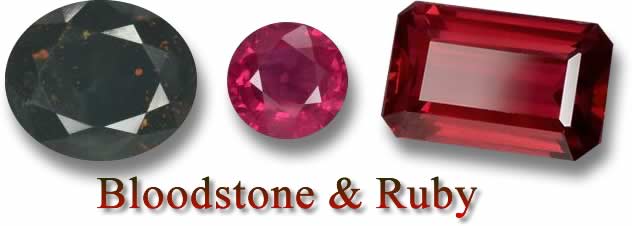
December is such an exciting month; with holidays such as Christmas and Hanukkah, as well as the approach of New Year, people born in this month are susceptible to the jitters and suspense we all feel during this time. Blue gemstones, particularly turquoise, tanzanite and zircon, can not only offer charming and elegant birthstone jewelry options, their color can impart calm and optimism to those who wear them.
As gemstones that can be worn every day in an appropriate setting and with proper care, turquoise, tanzanite and zircon are December birthstones that will hypnotize the eyes and bring hope to the heart. Visit our December birthstone product page and select your gemstone for you or your loved one today!

